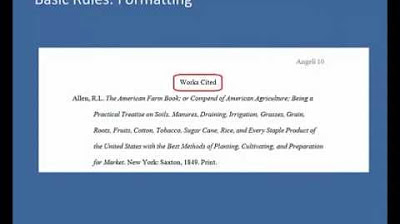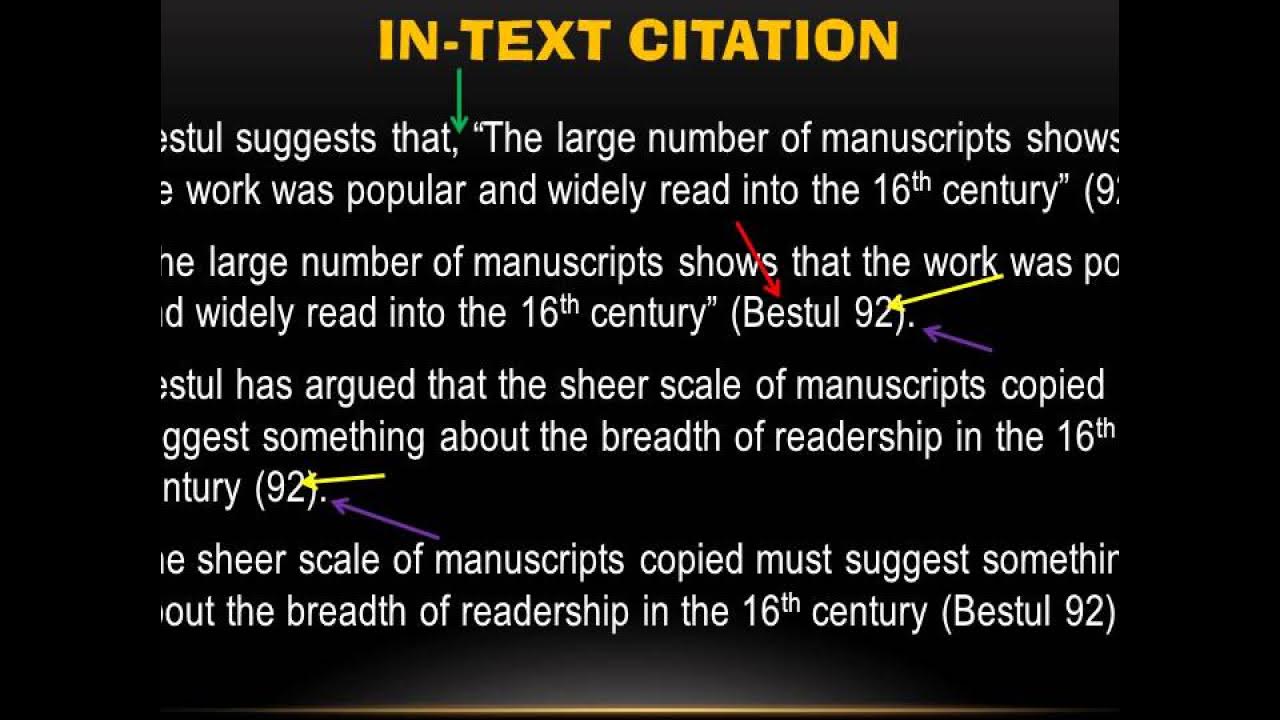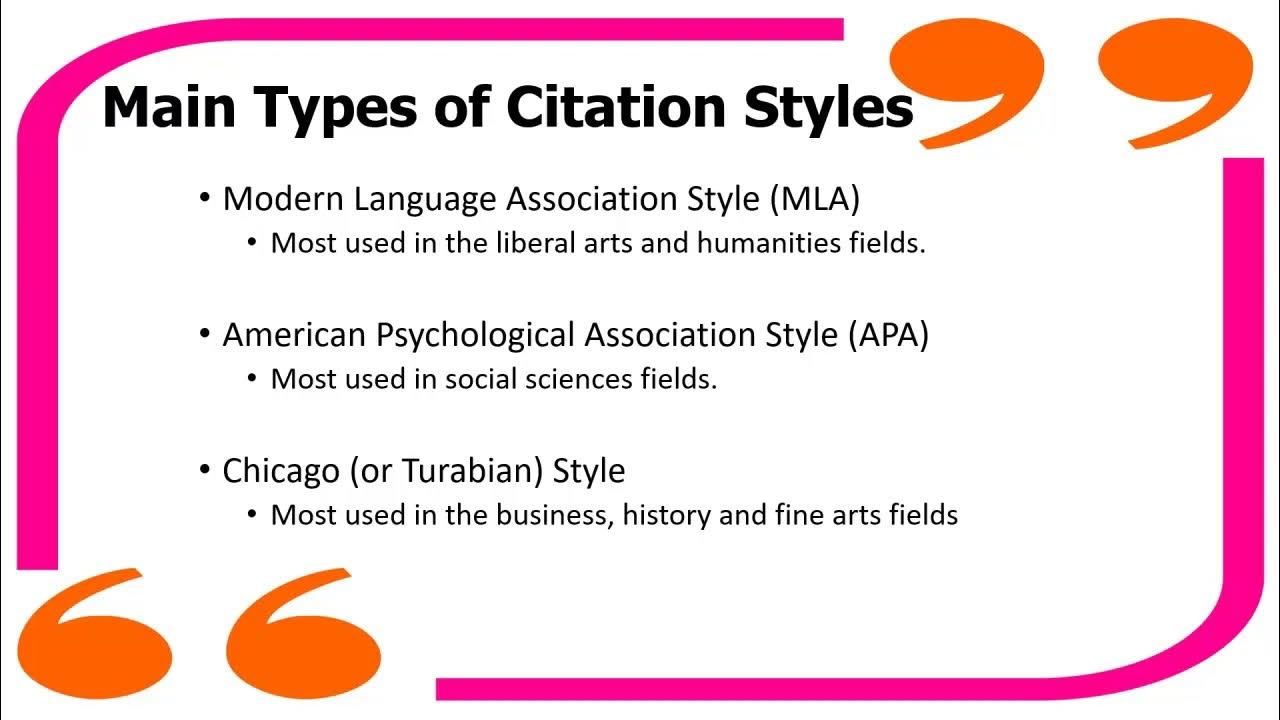Cite Right in MLA (9th Edition) Workshop
Summary
TLDRWelcome to the ELAC Libraries' Cite Right in MLA 9th Edition workshop, designed to equip you with the skills to define citation and plagiarism, and to cite books and articles in MLA style. Discover the importance of proper citation to avoid plagiarism and enhance your academic integrity. Learn about the different style guides and their relevance to various disciplines, with a focus on MLA for English and Humanities. Gain insights into creating in-text citations and full citations for a Works Cited page, and explore valuable online resources like the ELAC Libraries' citation guide and Excelsior OWL for further assistance. Practice with sample citations and utilize MLA style templates in Microsoft Word or Google Docs to format your research papers effectively.
Takeaways
- 😀 Citing is the formal way to give credit to sources used in academic research, involving acknowledging the original source or author of borrowed information.
- 🔍 There are multiple reasons to cite sources, including acknowledging scholars, allowing readers to follow up, clarifying the use of one's own versus others' ideas, showcasing research skills, and avoiding plagiarism.
- ⚠️ Plagiarism is the act of using someone else's work without proper credit and can lead to severe academic consequences like failing assignments or expulsion.
- 📚 To avoid plagiarism, one must cite sources when summarizing, paraphrasing, quoting directly, or using non-original graphics and data.
- 📘 Style guides like MLA, APA, and Chicago are discipline-specific and provide rules for citing sources and formatting papers.
- 📖 MLA style, used in English and Humanities, requires two types of citations: in-text citations in the body of the paper and full citations on a Works Cited page.
- 📑 In-text citations in MLA style should be in parentheses at the end of the sentence, including the author's name and page number.
- 📋 Creating full citations involves identifying the source type, gathering necessary information, and following the style guide's formatting rules for punctuation, capitalization, and more.
- 🌐 Free MLA resources are available online, including the ELAC Libraries’ citation guide and the Excelsior OWL, which offer examples and guidance for various source types.
- 📝 When formatting a Works Cited page, ensure it starts on a new page, is double-spaced with a hanging indent, and that citations are in alphabetical order.
Q & A
What is the main purpose of the ELAC Libraries' Cite Right in MLA 9th Edition workshop?
-The main purpose is to equip participants with the ability to define citation and plagiarism, cite a book and an article in MLA style, and guide them on how to access further MLA resources online.
Why is it important to cite sources in academic research?
-Citing sources is crucial to give credit to the original authors, allow readers to verify and follow up on sources, clarify the distinction between one's own ideas and those of others, and to demonstrate research skills. It also helps avoid plagiarism.
What are the consequences of plagiarism in academic settings?
-Consequences of plagiarism can range from failing an assignment or a class to potential expulsion from college, as it violates academic integrity.
What is the difference between in-text citations and full citations in MLA style?
-In-text citations are brief and placed within the body of the paper, directing readers to the full citations found in the Works Cited page at the end of the paper.
How has the MLA Handbook changed from the 8th to the 9th edition?
-The 9th edition of the MLA Handbook, released in April 2021, has not seen significant changes in citation and paper formatting from the 8th edition. However, there have been updates in accepted language, including the use of gender-neutral pronouns.
What are the two types of citations required in MLA style?
-The two types of citations required in MLA style are in-text citations within the body of the paper and full citations listed in the Works Cited page.
Where can one find the MLA Quick Guide and other MLA resources mentioned in the workshop?
-The MLA Quick Guide and other resources can be found on the ELAC Libraries' website at researchguides.elac.edu/citation and on the Excelsior Online Writing Lab (OWL).
How should the Works Cited page be formatted in MLA style?
-The Works Cited page should start on a new page, be double-spaced, use a hanging indent, and list citations in alphabetical order by the first word of the citation, usually the author's last name.
What are some online resources recommended for learning MLA citation style?
-Recommended online resources include the ELAC Libraries' MLA Citation Guide, the Excelsior OWL's MLA guide, and various YouTube tutorials for technical aspects of MLA formatting.
How can participants demonstrate their understanding of MLA citation after the workshop?
-Participants can take an MLA Quiz provided in their professor's Canvas course or an online quiz at bit.ly/CiteRightMLAform to test their knowledge and understanding of MLA citation.
Outlines

This section is available to paid users only. Please upgrade to access this part.
Upgrade NowMindmap

This section is available to paid users only. Please upgrade to access this part.
Upgrade NowKeywords

This section is available to paid users only. Please upgrade to access this part.
Upgrade NowHighlights

This section is available to paid users only. Please upgrade to access this part.
Upgrade NowTranscripts

This section is available to paid users only. Please upgrade to access this part.
Upgrade Now5.0 / 5 (0 votes)





